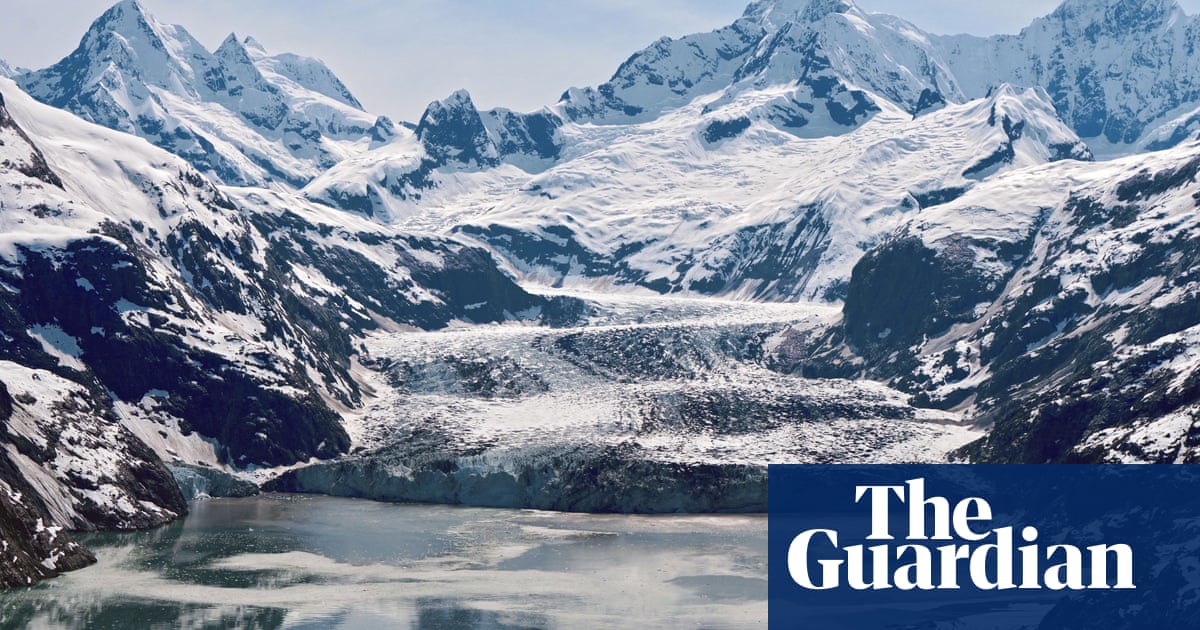
“It’s beautifully overwhelming,” says Michael Wejchert of the rock, ice and alpine routes he has climbed all over the world. “There’s a moment that anybody who’s climbed in a remote part of the Alaska range can remember where the plane flies away and suddenly the sound of the engine fades and you’re completely alone on a glacier, miles and miles from anywhere and that silence, especially at first, is deafening. It’s an incredible environment.”
But the pristine beauty comes with a hint of menace, perhaps most famously captured in Touching the Void, Joe Simpson’s gripping memoir of a fight for survival after falling from an ice cliff, breaking his leg and being “left for dead” in a storm in the Peruvian Andes.
While Simpson is now in his early 60s, Wejchert is from a new generation of climbers. The 36-year-old is also a writer and has delivered a new survival story about a 2018 expedition in a far-flung Alaskan mountain range, a calamitous accident and daring rescue attempt, and the physical and psychological scars left behind.
Hidden Mountains: Survival and Reckoning After a Climb Gone Wrong is the story of two couples who were experienced climbers and, with careful and cautious planning, tackled two virtually unexplored peaks in Alaska. One of the couples was Emmett Lyman, 40, and his 29-year-old girlfriend, Lauren Weber.
As the book’s prologue tells it: “Suddenly Lauren was snapped out of her reverie by a violent, wrenching sound. She felt the rope come tight and knew that on the other side Emmett was falling, though she couldn’t see him. Rock and debris flushed down the snow gully to her left so forcefully that it caused a small avalanche. To Lauren, the snow just looked like water cascading down, some unreal force of nature that still didn’t seem like it was happening. Dust clouded the air.
“Somewhere in this ‘I heard a human sound,’ she recalled. ‘It wasn’t words. It was just a sound of … maybe surprise and dismay.’”
Lyman was stranded, critically injured and invisible to the rest of the group. For the next nine hours, Weber and the other couple – Alissa Doherty and John Gassel – tried to reach him. Eventually, in thick fog and perilous conditions, an elite pararescue team hoisted him to a helicopter – alive but with traumatic brain and spinal cord injuries.
Wejchert was briefly acquainted with the climbers and was stirred by their ambition in striking out into uncharted territory in one of the remotest regions of the US. “Getting to this place is incredibly hard to do,” he says via Zoom from New Hampshire’s White Mountains, where he lives in a cabin with his wife, who is also his climbing partner.
“It took the climbers about a week to get to where they were and without technology like a DeLorme inReach [satellite communicator], or now a Garmin inReach, which is what the climbers had, this rescue would have been impossible, inaccessible.
“Fifty years ago climbers went into the mountains with the knowledge that they were probably on their own and now, for better or worse, we’re not when we go into these mountains. That was one striking aspect of why this story was so remarkable.”
The other compelling narrative was the struggle to bring Lyman home. “There are many other instances of heroic rescues but the fact that there were these two couples who would not abandon each other struck me as absolute heroism. I found myself wondering what I would do in a similar circumstance as a nightmare scenario for climbers.”
Flying a helicopter in mountain terrain is difficult and Lyman had fallen in a spot with low visibility that was particularly hard to reach. Wejchert adds: “One thing that the pilots and people in the helicopter remembered was waiting for the weather and looking up at this mountain and thinking: this is going to be pretty tricky.”
But they pulled it off and Lyman was airlifted to hospital in Anchorage. Doherty set up a GoFundMe page to help pay for his medical care. Wejchert, whose book is littered with insights into the social subculture of climbing, notes that, although some of the rescue was covered by insurance, GoFundMe has become a “sad necessity” in climbing accidents to fill financial gaps.
Lyman returned home to Boston a quadriplegic. The insurance would not cover the cost of a full-time caregiver and Weber found it hard to fill the role. As the first anniversary of the accident approached, she told Lyman that she could no longer maintain their relationship. The metaphorical cutting of the rope was devastating for both of them. Lyman said: “I cried a lot. I think I cried for about a month.”
Wejchert comments: “It’s a sad truth, especially in the adventure community, when people encounter life-altering injuries, the toll that they take is devastating on relationships in many instances. Every relationship is different and there are things that obviously nobody can truly know. It became untenable for both physical and emotional reasons and that’s one of the tragedies of the story.
“Lauren was in a unique position of having to care for somebody who had suffered very real physical and emotional trauma while picking up the pieces herself and that’s a lot to ask of somebody. To have seen and heard what she saw, as well as to have to continue on in that relationship, I’m sure took a massive toll.”
During his research, Wejchert found Weber fearful of how she would be portrayed during the events after Lyman’s rescue and unwilling to speak about most of what happened. He writes: “But perhaps her fear says more about the outdoor community or our expectations of what a spouse should do than it does about Lauren herself.
“Sadly, this stigma appears to hold especially for female survivors, for whom there is a societal expectation to remain ardent and steadfast in their care, even when the trauma of an accident has extended to them.”
The break-up left Lyman feeling hopeless and without a path forward. But with sterling support from family and friends, he gradually rebuilt his life. He still has an undaunted spirit and streak of independence: he engineers solutions to get through daily life and has just bought a house, which he is renovating.
Despite all the loss, Wejchert says, Lyman does not regret embarking on that audacious climb. “He’s said multiple times and will continue to say that, if he had to do it all over again, he would have taken that risk. It was something that compelled him.
“This was a life-altering moment for him and what he reflects on most is the friendships that he had forged saved his life. He’s adamant that was the case and he’s right. But he thinks about it daily and he still loves the idea of climbing. He wants to be as involved as possible despite the magnitude of his injuries and so that’s very inspiring.”
Investigating the case, and getting to know Lyman, has transformed the way in which Wejchert himself thinks about climbing, however. “I encounter and react to risk very differently than I would maybe five years ago even. The type of climbing I do has changed as well: sunny rock climbing as opposed to going on these mountain trips. I still grapple with that. I still love to climb the mountains but my ambitions have scaled down. Not entirely because of this, of course, but I think it’s a factor.”
Even so, Wejchert has plans to go climbing in the Alaska range later this year. “I can only speak for myself but the appeal is this amazing technical challenge in a landscape that is breathtaking.
“We’re so connected now, we rarely have a chance to step outside our comfort zones, so when you enter the mountains and have this mental and physical problem-solving aspect, and you’re able to piece everything together on the good days when you’re climbing well, and when you’re figuring all that stuff out with a partner, life is distilled into this simple: what ledge can I sleep on? Will I be able to climb the next bit of ice or rock? What’s going to happen with the weather?
“There’s this beautiful simplicity and rhythm and cadence to the sport that is addictive. That’s why I do it. It’s incredibly enjoyable and rewarding movement in an environment that you would never get to see otherwise.”
Climbing is now more accessible and popular than ever: there are an estimated 7 million people doing it in America alone, as evidenced by a proliferation of rock gyms. It has become safer thanks to advances in equipment and training. Some climbers are addicted to the dangers; others not so much.
Wejchert reflects: “I climb despite the risk and not because of it. Mitigating those risks as much as humanly possible is part of the challenge. The clarity that being in those dangerous environments provides is addictive and it’s something that affects people whether they want it to or not. People have different risk tolerances at different times so different climbs are more or less dangerous.”
But the risks of avalanches and ice and rock falls have been made harder to predict by the climate crisis. Wejchert wrote a guest essay for the New York Times last Christmas Day under the headline: “Ice Climbing Is Having Its Moment, but How Much Longer Will the Ice Be Around?”
He explains: “We are facing a dramatically warming climate and climbers have long been the canary in the coalmine because we have such benchmarks and they’re visual. I think of a glacier in the Canadian Rockies called the Columbia Icefield that I visited several times and visibly these things are receding.
“Look at Cordillera Huayhuash where Touching the Void took place and those mountains are completely different from what they were even 20 years ago, or the unprecedented warmth in the Alps, especially last summer.”
Wejchert warns: “The benchmark of freezing is getting harder and harder to maintain and the risks that climbers have always encountered are suddenly becoming harder to predict because the mountains are melting. We don’t have enough data yet of ‘the new normal’ to know exactly how that’s going to affect places like the Alps.”
Hidden Mountains: Survival and Reckoning After a Climb Gone Wrong is out now












